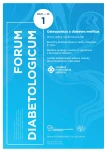Osteoporosis in endocrinopathies
Authors:
Juraj Payer; Peter Jackuliak
Authors‘ workplace:
V. interná klinika LF UK a UNB, Nemocnica Ružinov, Bratislava
Published in:
Forum Diab 2021; 10(1): 4-9
Category:
Overview
Osteoporosis is now recognized, together with cardiovascular and oncology diseases as a civilization disease. It represents a significant growing, worldwide health problem. The high incidence of osteoporosis and fractures contribute significantly to morbidity, mortality and increased health care costs. We can divide osteoporosis in two main groups – primary and secondary osteoporosis. Secondary osteoporosis is due to a known or yet unidentified (asymptomatic) disease or long-term treatment, adversely affecting bone metabolism. So in primary osteoporosis as well as in the secondary osteoporosis it is usually a disorder associated with changes in hormone activity. The most common is the primary estrogen-deficient postmenopausal osteoporosis. However, osteoporosis is caused by a disorder of secretion of cortisol, growth hormone, thyroid, parathyroid or impaired secretion or insulin action. Except antiporotic treatment in all cases must be treated also the hormone disorder. The authors provide an overview of the root causes of endocrine conditional osteoporosis, its etiopathogenesis, clinical manifestations, diagnosis and treatment of basic principles.
Keywords:
endocrinopathies – hormonal changes – osteoporosis
Sources
- Wass JAH, Turner H. Oxford Handbook od Endocrinology and Diabetes. Oxford Univesity Press: Oxford 2006: 548–552. ISBN: 0–19–263052–0.
- Gardner D, Shoback D. Greenspan‘s Basic and Clinical Endocrinology. 9th ed. McGraw-Hill Medical: China 2011: 244–250. ISBN 978–0071622431.
- Bilezikian J, Khan AA, Potts JT Jr. Guidelines for the Management of Asymptomatic Primary Hyperparathyroidism: Summary Statment from the 3rd International Workshop. J Clin Endocrinol Metab 2009; 94(2): 335–339. Dostupné z DOI: <http://dx.doi.org/10.1210/jc.2008–1763>.
- Van Staa TP, Leufkens HG, Cooper C. The epidemiology of corticosteroid-induced osteoporosis: a meta-analysis. Osteoporos Int 2002; 13(10): 777–787. Dostupné z DOI: <http://dx.doi.org/10.1007/s001980200108>.
- Zikán V. Glukokortikoidy a osteoporóza. Vnitř Lék 2007; 53(7–8): 831–840.
- Van Staa TP, Leufkens HGM, Abenhaim L et al. Oral corticosteroids and fracture risk: relationship to daily and cumulative doses. Rheumatology (Oxford) 2000; 39(12): 1383–1389. Dostupné z DOI: <http://dx.doi.org/10.1093/rheumatology/39.12.1383>.
- Van Staa T, Leufkens HGM, Abenhaim L et al. Use of oral corticosteroids and risk of fractures. J Bone MinerRes 2000; 15(6): 993–1000. Dostupné z DOI: <http://dx.doi.org/10.1359/jbmr.2000.15.6.993>.
- Van Staa TP. The pathogenesis, epidemiology and management of glucocorticoid-induced osteoporosis. Calcif Tissue Int 2006; 79(3) :129–137. Dostupné z DOI: <http://dx.doi.org/10.1007/s00223–006–0019–1>.
- Payer J, Killinger Z a kol. Osteoporóza.: Herba: Bratislava 2012. ISBN 978–80–8971–94–1.
- Kanis JA, Johnell O, Oden A et al. FRAX and theassessment of fracture probability in men and women from the UK. Osteoporos Int 2008;19(4):385–397. Dostupné z DOI: <http://dx.doi.org/10.1007/s00198–007–0543–5>.
- Saag KG, Shane E, Boonen S et al. Teriparatide or alendronate in glucocorticoid-induced osteoporosis. N Engl J Med 2007; 357(20): 2028–2039. Dostupné z DOI: <http://dx.doi.org/10.1056/NEJMoa071408>.
- Štěpán J. Glukokortikoidy indukovaná osteoporóza: Nové možnosti prevence a léčby. Interní Med 2008; 10(7–8): 323–326.
- Čierny D, Killinger Z, Payer J. Postavenie teriparatidu a intaktného parathormónu v liečbe osteoporózy. Slov Lek 2007; 17(9–10): 226–230.
- Baqi L, Payer J. Tyreoidálne hormóny a kosť. Ost Bull 2003; 2: 33–42.
- Kužma M, Payer J. Deficit rastového hormónu a jeho vplyv na kostnú minerálnu denzitu a riziko osteoporotických fraktúr. Cas Lek Cesk 2010; 149(5): 211–216.
- Janghorbani M, Van Dam RM, Willett WC et al. Systematic review of type 1 and type 2 diabetes mellitus and risk of fracture. Am J Epidemiol 2007; 166(5): 495–505. Dostupné z DOI: <http://dx.doi.org/10.1093/aje/kwm106>.
- Vestergaard P, Rejnmark L, Mosekilde L. Relative fracture risk in patients with diabetes mellitus, and the impact of insulin and oral antidiabetic medication on relative fracture risk. Diabetologia 2005; 48(7): 1292–1299. Dostupné z DOI: <http://dx.doi.org/10.1007/s00125–005–1786–3>.
- Vestník MZ SR 2009, čiastka 52, s. 379–381.
Labels
Diabetology Endocrinology Internal medicineArticle was published in
Forum Diabetologicum

Most read in this issue
- Second generation basal insulin analogues in clinical trials using continuous monitoring of glucose levels
- Osteoporosis in endocrinopathies
- De-intensification of treatment in patient with diabetes mellitus could be beneficial
- Population differences in the prevalence of diabetes mellitus, its risk factors and complications
